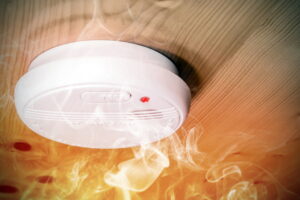The modern standard for homes is to have smoke and carbon monoxide detectors installed in various rooms. These devices are common enough that most people don’t think about them—until they have to.
We deal with carbon monoxide (CO) in homes as part of our job. We install CO detectors and offer carbon monoxide testing Ellensburg, WA for HVAC devices to help keep homes safe. Today, we want to explore in more depth the importance of having a detection system in place to protect your home against the dangers of carbon monoxide. We’ll examine why CO is dangerous and where it comes from in your home.
What is carbon monoxide?
Carbon monoxide is a highly toxic gas produced by the incomplete combustion of carbon-containing fuels. This includes common household sources such as gas appliances, wood-burning stoves, and even vehicles in an attached garage. What makes CO especially dangerous is it is difficult for humans to detect: it lacks color, taste, and smell, making it nearly impossible to detect without special equipment.
Why carbon monoxide is dangerous
Exposure to carbon monoxide can have severe health consequences. Symptoms of CO poisoning range from headaches and dizziness to nausea, confusion, and, in extreme cases, death. Long-term exposure can lead to chronic health issues.
Where can carbon monoxide come from in my home?
The main source of carbon monoxide entering into your living spaces is through appliances that burn fossil fuels. If your home uses natural gas in any capacity—stove, oven, furnace, water heater, laundry machine—there’s a possibility of CO leaks. But all-electric homes have sources of CO as well, such as blocked chimneys and malfunctioning appliances.
The role of carbon monoxide detectors
CO detectors are your first and best line of defense against the dangers of carbon monoxide poisoning. These devices continuously monitor the air for the presence of CO and emit a loud alarm when levels become dangerous. The detectors need to be properly placed so they’re installed near sleeping areas and on each floor of a home. There are various types of CO detectors available, including battery-operated stand-alone units, plug-in units, and hardwired models.
Call us for CO detector installation
We recommend hardwired carbon monoxide detectors: they’re reliable and won’t lose power in blackouts because of their battery backup. You’ll want skilled technicians to handle the installation. Our technicians understand where to place CO detectors and how to wire them up for dependable performance. You’ll feel much more relaxed about your family’s protection against carbon monoxide poisoning when our pros have done the work to install state-of-the-art detection devices.
Remember to regularly test your CO detectors
Merely having carbon monoxide detectors installed is not enough protection. You need to test these devices regularly to make sure they’re working. DIY testing is simple, but we also recommend scheduling professional inspections to identify any potential issues early.
Your CO detectors won’t last forever, and at some point, you’ll need to have them replaced. If you live in an older home that still has the same CO detectors in place, you might want to work with our team to replace and upgrade them. If your detectors are frequently creating false alarms, it’s also a good idea to look into replacements.
Call ThermAll Heating & Cooling, Inc: We are “Your Home Comfort Hero!”

